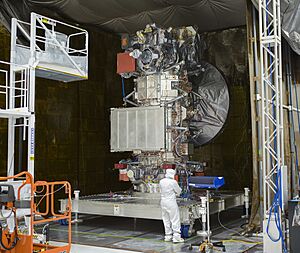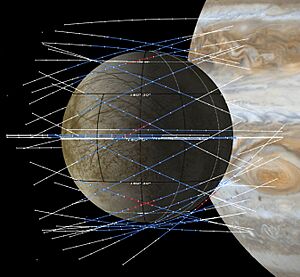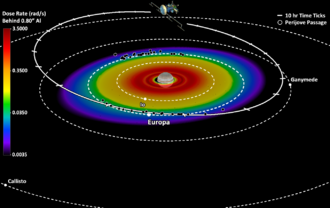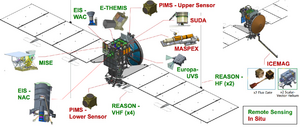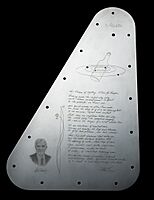Europa Clipper facts for kids
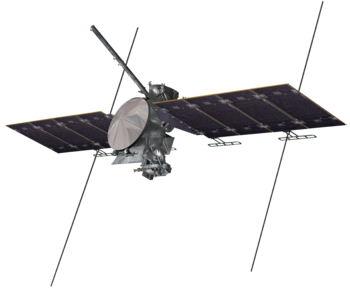
Artist's rendering of the Europa Clipper spacecraft
|
|
| Names | Europa Multiple Flyby Mission |
|---|---|
| Mission type | Europa reconnaissance |
| Operator | NASA |
| Mission duration | Cruise: 5.5 years Science phase: 4 years Elapsed: 183 days, 22 hours, 33 minutes |
| Spacecraft properties | |
| Manufacturer | Jet Propulsion Laboratory |
| Launch mass | 6,065 kg (13,371 lb), including 2,750 kg (6,060 lb) propellant |
| Dry mass | 3,241 kg (7,145 lb) |
| Payload mass | 352 kg (776 lb) |
| Dimensions | Height: 6 m (20 ft) Solar panel span: 22 m (72 ft) |
| Power | 600 watts from solar panels |
| Start of mission | |
| Launch date | October 14, 2024, 16:06:00 UTC (12:06 pm EDT) |
| Rocket | Falcon Heavy Block 5 |
| Launch site | Kennedy, LC-39A |
| Contractor | SpaceX |
| Flyby of Mars (gravity assist) | |
| Closest approach | February 2025 |
| Flyby of Earth (gravity assist) | |
| Closest approach | December 2026 |
| Jupiter orbiter | |
| Orbital insertion | April 11, 2030 (planned) |
| Orbits | 45 |
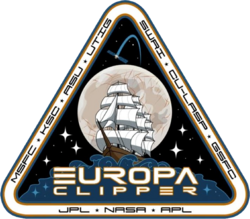 Europa Clipper mission patch Large Strategic Science Missions
Planetary Science Division |
|
Europa Clipper (previously known as Europa Multiple Flyby Mission) is a space probe developed by NASA to study Europa, a Galilean moon of Jupiter. It was launched on October 14, 2024, and is expected to arrive in the Jupiter system in 2030. The spacecraft will then perform a series of flybys of Europa while in orbit around Jupiter. The spacecraft is larger than any other used for previous NASA planetary missions.
Europa Clipper will perform follow-up studies to those made by the Galileo spacecraft during its eight years (1995–2003) in Jupiter orbit, which indicated the existence of a subsurface ocean underneath Europa's ice crust. Plans to send a spacecraft to Europa were initially conceived with projects such as Europa Orbiter and Jupiter Icy Moons Orbiter, in which a spacecraft would be injected into orbit around Europa. However, due to the adverse effects of radiation from Jupiter's magnetosphere in Europa orbit, it was decided that it would be safer to inject a spacecraft into an elliptical orbit around Jupiter and make 44 close flybys of the moon instead. The mission began as a joint investigation between the Jet Propulsion Laboratory (JPL) and the Applied Physics Laboratory (APL), and was built with a scientific payload of nine instruments contributed by JPL, APL, Southwest Research Institute, University of Texas at Austin, Arizona State University and University of Colorado Boulder. Europa Clipper complements ESA's Jupiter Icy Moons Explorer, launched in 2023, which will fly-by Europa twice and Callisto multiple times before moving into orbit around Ganymede.
Europa Clipper was launched on October 14, 2024, aboard a Falcon Heavy rocket in a fully expended configuration. The spacecraft will use gravity assists from Mars in February 2025 and Earth in December 2026, before arriving at Europa in April 2030.
Contents
- History
- Objectives
- Design and construction
- Power
- Propulsion
- Scientific payload
- Europa Thermal Emission Imaging System (E-THEMIS)
- Mapping Imaging Spectrometer for Europa (MISE)
- Europa Imaging System (EIS)
- Europa Ultraviolet Spectrograph (Europa-UVS)
- Radar for Europa Assessment and Sounding: Ocean to Near-surface (REASON)
- Europa Clipper Magnetometer (ECM)
- Plasma Instrument for Magnetic Sounding (PIMS)
- Mass Spectrometer for Planetary Exploration (MASPEX)
- Surface Dust Analyzer (SUDA)
- Gravity/Radio Science
- Launch and trajectory
- Public outreach
- See also
History
In 1997, a Europa Orbiter mission was proposed by a team for NASA's Discovery Program but was not selected. NASA's JPL announced one month after the selection of Discovery proposals that a NASA Europa orbiter mission would be conducted. JPL then invited the Discovery proposal team to be the Mission Review Committee (MRC).
At the same time as the proposal of the Discovery-class Europa Orbiter, the robotic Galileo spacecraft was already orbiting Jupiter. From December 8, 1995, to December 7, 1997, Galileo conducted the primary mission after entering the orbit of Jupiter. On that final date, the Galileo orbiter commenced an extended mission known as the Galileo Europa Mission (GEM), which ran until December 31, 1999. This was a low-cost mission extension with a budget of only US$30 million. The smaller team of about 40–50 people (compared with the primary mission's 200-person team from 1995 to 1997) did not have the resources to deal with problems, but when they arose, it was able to temporarily recall former team members (called "tiger teams") for intensive efforts to solve them. The spacecraft made several flybys of Europa (8), Callisto (4) and Io (2). On each flyby of the three moons it encountered, the spacecraft collected only two days' worth of data instead of the seven it had collected during the primary mission. This Galileo Europa Mission was similar to a small-scale version of what the Europa Clipper is planning to accomplish. GEM included eight flybys of Europa, ranging from 196 to 3,582 km (122 to 2,226 mi), in two years.
Europa has been identified as one of the locations in the Solar System that could possibly harbor microbial extraterrestrial life. Immediately following the Galileo spacecraft's discoveries and the independent Discovery program proposal for a Europa orbiter, JPL conducted preliminary mission studies that envisioned a capable spacecraft such as the Jupiter Icy Moons Orbiter (a US$16 billion mission concept), the Jupiter Europa Orbiter (a US$4.3 billion concept), another orbiter (US$2 billion concept), and a multi-flyby spacecraft: Europa Clipper.
A mission to Europa was recommended by the National Research Council in 2013. The approximate cost estimate rose from US$2 billion in 2013 to US$4.25 billion in 2020. The mission is a joint project between the Johns Hopkins University's Applied Physics Laboratory (APL), and the Jet Propulsion Laboratory (JPL). The mission's name is a reference to the lightweight clipper ships of the 19th century that routinely plied trade routes around the world. The moniker was chosen because the spacecraft will "sail" past Europa, as frequently as every two weeks.
In March 2013, US$75 million was authorized to expand on the formulation of mission activities, mature the proposed science goals, and fund preliminary instrument development, as suggested in 2011 by the Planetary Science Decadal Survey. In May 2014, a House bill substantially increased the Europa Clipper (referred to as Europa Multiple Flyby Mission) funding budget for the 2014 fiscal year from US$15 million to US$100 million to be applied to pre-formulation work. Following the 2014 election cycle, bipartisan support was pledged to continue funding for the Europa Multiple Flyby Mission project. The executive branch also granted US$30 million for preliminary studies.
In April 2015, NASA invited the European Space Agency to submit concepts for an additional probe to fly together with the Europa Clipper spacecraft, with a mass limit of 250 kg. It could be a simple probe, an impactor, or a lander. An internal assessment at European Space Agency (ESA) considered whether there was interest and funds available, opening a collaboration scheme similar to the very successful Cassini-Huygens approach. In May 2015, NASA chose nine instruments that would fly on board the orbiter, budgeted to cost about US$110 million over the next three years. In June 2015, NASA approved the mission concept, allowing the orbiter to move to its formulation stage. In January 2016, NASA approved the addition of a lander, but this was canceled in 2017 because it was deemed too risky. In May 2016, the Ocean Worlds Exploration Program was approved, of which the Europa mission is part.
In February 2017, the mission moved from Phase A to Phase B (the preliminary design phase). On July 18, 2017, the House Space Subcommittee held hearings on the Europa Clipper as a scheduled Large Strategic Science Missions class, and to discuss a possible follow up mission simply known as the Europa Lander. Phase B continued into 2019. In addition, subsystem vendors were selected, as well as prototype hardware elements for the science instruments. Spacecraft sub-assemblies were built and tested as well.
In July 2024, the spacecraft faced concerns of delay and missing the launch window because of a discovery in June 2024 that its components were not as radiation-hardened as previously believed. On September 2024, it was approved for a launch window opening on October 10, 2024, however, on October 6, 2024, NASA announced that it would be standing down from the October 10 launch due to Hurricane Milton and was finally launched on October 14, 2024.
Fabrication and assembly
- On August 19, 2019, the Europa Clipper proceeded to Phase C: final design and fabrication.
- On March 3, 2022, the spacecraft moved on to Phase D: assembly, testing, and launch.
- On June 7, 2022, the main body of the spacecraft was completed.
- By January 30, 2024, all of the science instruments were added to the spacecraft. The REASON instrument's electronics were aboard the spacecraft, while its antennas were added to the spacecraft's solar arrays at Kennedy Space Center later in the year.
- In March 2024, it was reported that the spacecraft underwent successful testing and was on track for launch later in the year.
- In May 2024, the spacecraft arrived at Kennedy Space Center for final launch preparations.
- In September 2024, final pre-launch review was successfully completed, clearing the way for launch.
- In early October 2024, due to the incoming Hurricane Milton, the spacecraft was placed in secure storage for safekeeping until the hurricane passed.
End of mission planning
In June 2022, project scientist Robert Pappalardo revealed that mission planners for Europa Clipper were considering disposing of the probe by crashing it into the surface of Ganymede for planetary protection purposes, in case an extended mission was not approved early. He noted that an impact would help the ESA's JUICE mission collect more information about Ganymede's surface chemistry. In a 2024 paper, Pappalardo said the mission would last four years in Jupiter orbit, and that the disposal was targeted for September 3, 2034, on the condition that NASA did not negotiate a delay.
Objectives
The goals of Europa Clipper are to explore Europa, investigate its habitability and aid in the selection of a landing site for the proposed Europa Lander. This exploration is focused on understanding the three main requirements for life: liquid water, chemistry, and energy. Specifically, the objectives are to study:
- Ice shell and ocean: Confirm the existence and characterize the nature of water within or beneath the ice, and study processes of surface-ice-ocean exchange.
- Composition: Distribution and chemistry of key compounds and the links to ocean composition.
- Geology: Characteristics and formation of surface features, including sites of recent or current activity.
Strategy
Because Europa lies well within the harsh radiation fields surrounding Jupiter, even a radiation-hardened spacecraft in near orbit would be functional for just a few months. Most instruments can gather data far faster than the communications system can transmit it to Earth due to the limited number of antennas available on Earth to receive the scientific data. Therefore, another key limiting factor on science for a Europa orbiter is the time available to return data to Earth. In contrast, the amount of time during which the instruments can make close-up observations is less important.
Studies by scientists from the Jet Propulsion Laboratory show that by performing several flybys with many months to return data, the Europa Clipper concept will enable a US$2 billion mission to conduct the most crucial measurements of the canceled US$4.3 billion Jupiter Europa Orbiter concept. Between each of the flybys, the spacecraft will have seven to ten days to transmit data stored during each brief encounter. That will let the spacecraft have up to a year of time to transmit its data compared to just 30 days for an orbiter. The result will be almost three times as much data returned to Earth, while reducing exposure to radiation. Europa Clipper will not orbit Europa but will instead orbit Jupiter and conduct 44 flybys of Europa, each at altitudes ranging from 25 km to 2,700 km (16 mi to 1,678 mi) during its 3.5-year mission. A key feature of the mission concept is that Europa Clipper would use gravity assists from Europa, Ganymede and Callisto to change its trajectory, allowing the spacecraft to return to a different close approach point with each flyby. Each flyby would cover a different sector of Europa to achieve a medium-quality global topographic survey, including ice thickness. Europa Clipper could conceivably fly by at low altitude through the plumes of water vapor erupting from the moon's ice crust, thus sampling its subsurface ocean without having to land on the surface and drill through the ice.
The spacecraft is expected to receive a total ionizing dose of 2.8 megarads (28 kGy) during the mission. Shielding from Jupiter's harsh radiation belt will be provided by a radiation vault with 0.3 inches (7.6 mm) thick aluminum alloy walls, which enclose the spacecraft electronics. To maximize the effectiveness of this shielding, the electronics are also nested in the core of the spacecraft for additional radiation protection.
Design and construction
This mission is a flight of NASA's Planetary Science Division, designated a Large Strategic Science Mission, and funded under the Planetary Missions Program Office's Solar System Exploration program as its second flight. It is also supported by the new Ocean Worlds Exploration Program.
Power
Both radioisotope thermoelectric generator (RTG) and photovoltaic power sources were assessed to power the orbiter. Although solar power is only 4% as intense at Jupiter as it is in Earth's orbit, powering a Jupiter orbital spacecraft by solar panels was demonstrated by the Juno mission. The alternative to solar panels was a multi-mission radioisotope thermoelectric generator (MMRTG), fueled with plutonium-238. The power source has already been demonstrated in the Mars Science Laboratory (MSL) mission. Five units were available, with one reserved for the Mars 2020 rover mission and another as backup. In September 2013, it was decided that the solar array was the less expensive option to power the spacecraft, and on October 3, 2014, it was announced that solar panels were chosen to power Europa Clipper. The mission's designers determined that solar power was both cheaper than plutonium and practical to use on the spacecraft. Despite the increased weight of solar panels compared to plutonium-powered generators, the vehicle's mass had been projected to still be within acceptable launch limits.
Each panel has a surface area of 18 m2 (190 sq ft) and produce 150 watts continuously when pointed towards the Sun while orbiting Jupiter. While in Europa's shadow, batteries will enable the spacecraft to continue gathering data. However, ionizing radiation can damage solar panels. The Europa Clipper's orbit will pass through Jupiter's intense magnetosphere, which is expected to gradually degrade the solar panels as the mission progresses. The solar panels were provided by Airbus Defence and Space, Netherlands.
Propulsion
The propulsion subsystem was built by NASA's Goddard Space Flight Center in Greenbelt, Maryland. It is part of the Propulsion Module, delivered by Johns Hopkins Applied Physics Laboratory in Laurel, Maryland. It is 3 metres (10 ft) tall, 1.5 metres (5 ft) in diameter and comprises about two-thirds of the spacecraft's main body. The propulsion subsystem carries nearly 2,700 kilograms (6,000 lb) of monomethyl hydrazine and dinitrogen tetroxide propellant, 50% to 60% of which will be used for the 6 to 8-hour Jupiter orbit insertion burn. The spacecraft has a total of 24 rocket engines rated at 27.5N (6.2lbf) thrust for attitude control and propulsion.
Scientific payload
The Europa Clipper mission is equipped with nine scientific instruments. The electronic components are protected from the intense radiation by a 150-kilogram titanium and aluminum shield. The spacecraft payload and trajectory are subject to change as the mission design matures. The nine science instruments for the orbiter, announced in May 2015, have a planned total mass of 82 kg (181 lb); they are:
Europa Thermal Emission Imaging System (E-THEMIS)
The Europa Thermal Emission Imaging System will provide high spatial resolution as well as multi-spectral imaging of the surface of Europa in the mid to far infrared bands to help detect geologically active sites and areas, such as potential vents erupting plumes of water into space. The principal investigator is Philip Christensen of Arizona State University. This instrument is derived from the Thermal Emission Imaging System (THEMIS) on the 2001 Mars Odyssey orbiter, also developed by Philip Christensen.
Mapping Imaging Spectrometer for Europa (MISE)
The Mapping Imaging Spectrometer for Europa is an imaging near infrared spectrometer to probe the surface composition of Europa, identifying and mapping the distributions of organics (including amino acids and tholins), salts, acid hydrates, water ice phases, and other materials. From these measurements, scientists expect to be able to relate the moon's surface composition to the habitability of its ocean. The principal investigator is Diana Blaney of Jet Propulsion Laboratory and the instrument was built in collaboration with the Johns Hopkins University Applied Physics Laboratory (APL).
Europa Imaging System (EIS)
The Europa Imaging System is a visible spectrum imaging suite to map Europa's surface and study smaller areas in high resolution, as low as 0.5 m (20 in) per pixel. The principal investigator is Elizabeth Turtle of the Applied Physics Laboratory. It consists of two cameras:
- The Wide-angle Camera (WAC) has a field of view of 48° by 24° and a resolution of 11 m (36 ft) from a 50 km (31 mi) altitude. The WAC will obtain stereo imagery swaths throughout the mission.
- The Narrow-angle Camera (NAC) has a 2.3° by 1.2° field of view, giving it a resolution of 0.5 m (20 in) per pixel from a 50 km (31 mi) altitude. The NAC is mounted on a 2-axis gimbal, allowing it to point at specific targets regardless of the main spacecraft's orientation. This will allow for mapping of >95% of Europa's surface at a resolution of ≤50 m (160 ft) per pixel. For reference, only around 14% of Europa's surface has previously been mapped at a resolution of ≤500 m (1,600 ft) per pixel.
Europa Ultraviolet Spectrograph (Europa-UVS)
The Europa Ultraviolet Spectrograph instrument will be able to detect small plumes and will provide valuable data about the composition and dynamics of the moon's exosphere. The principal investigator is Kurt Retherford of Southwest Research Institute. Retherford was previously a member of the group that discovered plumes erupting from Europa while using the Hubble Space Telescope in the UV spectrum.
Radar for Europa Assessment and Sounding: Ocean to Near-surface (REASON)
The Radar for Europa Assessment and Sounding: Ocean to Near-surface (REASON) is a dual-frequency ice penetrating radar (9 and 60 MHz) instrument that is designed to characterize and sound Europa's ice crust from the near-surface to the ocean, revealing the hidden structure of Europa's ice shell and potential water pockets within. REASON will probe the exosphere, surface and near-surface and the full depth of the ice shell to the ice-ocean interface up to 30 km. The principal investigator is Donald Blankenship of the University of Texas at Austin. This instrument was built by Jet Propulsion Laboratory.
Europa Clipper Magnetometer (ECM)
The Europa Clipper Magnetometer (ECM) will be used to characterize the magnetic fields around Europa. The instrument consists of three magnetic flux gates placed along a 25 ft boom, which were stowed during launch and deployed afterwards. By studying the strength and orientation of Europa's magnetic field over multiple flybys, scientists hope to be able to confirm the existence of Europa's subsurface ocean, as well as characterize the thickness of its icy crust and measure the water's depth and salinity. The instrument team leader is Margaret Kivelson, University of Michigan.
ECM replaced the proposed Interior Characterization of Europa using Magnetometry (ICEMAG) instrument, which was canceled due to cost overruns. ECM is a simpler and cheaper magnetometer than ICEMAG would have been.
Plasma Instrument for Magnetic Sounding (PIMS)

The Plasma Instrument for Magnetic Sounding (PIMS) measures the plasma surrounding Europa to characterize the magnetic fields generated by plasma currents. These plasma currents mask the magnetic induction response of Europa's subsurface ocean. In conjunction with a magnetometer, it is key to determining Europa's ice shell thickness, ocean depth, and salinity. PIMS will also probe the mechanisms responsible for weathering and releasing material from Europa's surface into the atmosphere and ionosphere and understanding how Europa influences its local space environment and Jupiter's magnetosphere. The principal investigator is Joseph Westlake of the Applied Physics Laboratory.
Mass Spectrometer for Planetary Exploration (MASPEX)
The Mass Spectrometer for Planetary Exploration (MASPEX) will determine the composition of the surface and subsurface ocean by measuring Europa's extremely tenuous atmosphere and any surface materials ejected into space. Jack Waite, who led development of MASPEX, was also Science Team Lead of the Ion and Neutral Mass Spectrometer (INMS) on the Cassini spacecraft. The principal investigator is Jim Burch of Southwest Research Institute, who was previously the leader of the Magnetospheric Multiscale Mission.
Surface Dust Analyzer (SUDA)
The SUrface Dust Analyzer (SUDA) is a mass spectrometer that will measure the composition of small solid particles ejected from Europa, providing the opportunity to directly sample the surface and potential plumes on low-altitude flybys. The instrument is capable of identifying traces of organic and inorganic compounds in the ice of ejecta, and is sensitive enough to detect signatures of life even if the sample contains less than a single bacterial cell in a collected ice grain. The principal investigator is Sascha Kempf of the University of Colorado Boulder.
Gravity/Radio Science
While not intended for use specifically as an instrument, Europa Clipper will use its radio antenna to perform additional experiments and learn about Europa's gravitational field. As the spacecraft performs each of its 45 flybys, its trajectory will be subtly altered by the moon's gravity. By sending radio signals between Earth and the moon and characterizing the Doppler shift in the return signal, scientists at JPL will be able to create a detailed characterization of the spacecraft's motion. This data will help to determine how Europa flexes in relation to its distance from Jupiter, which will in turn reveal information about the moon's internal structure and tidal motions. The instrument team leader is Erwan Mazarico of NASA's Goddard Space Flight Center.
Launch and trajectory
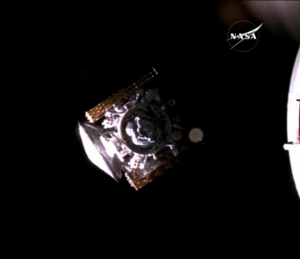
The ~840 m/s (1,900 mph) delta-V Jupiter orbit insertion burn will take place at a distance of 11 Rj (Jovian radii) from the planet following a 500 km (310 mi) Ganymede gravity assist flyby to reduce spacecraft velocity by ~400 m/s (890 mph). After this, the spacecraft will perform a ~122 m/s (270 mph) periapsis raise maneuver (PRM) rocket burn near the apoapsis of its initial 202-day period capture orbit.
Congress had originally mandated that Europa Clipper be launched on NASA's Space Launch System (SLS) super heavy-lift launch vehicle, but NASA had requested that other vehicles be allowed to launch the spacecraft due to a foreseen lack of available SLS vehicles. The United States Congress's 2021 omnibus spending bill directed the NASA Administrator to conduct a full and open competition to select a commercial launch vehicle if the conditions to launch the probe on a SLS rocket cannot be met.
On January 25, 2021, NASA's Planetary Missions Program Office formally directed the mission team to "immediately cease efforts to maintain SLS compatibility" and move forward with a commercial launch vehicle.
On February 10, 2021, it was announced that the mission would use a 5.5-year trajectory to the Jovian system, with gravity-assist maneuvers involving Mars (February 2025) and Earth (December 2026). Launch is targeted for a 21-day period between October 10 and 30, 2024, giving an arrival date in April 2030, and backup launch dates were identified in 2025 and 2026. Hurricane Milton caused a launch attempt for October 10 to be scrubbed.
The SLS option would have entailed a direct trajectory to Jupiter taking less than three years. One alternative to the direct trajectory was identified as using a commercial rocket, with a longer 6-year cruise time involving gravity assist maneuvers at Venus, Earth and/or Mars. Additionally, a launch on a Delta IV Heavy with a gravity assist at Venus was considered.
In July 2021 Falcon Heavy was chosen to launch the spacecraft. Three reasons were given: launch cost (+- $178 million), SLS availability, and "shaking". The move to Falcon Heavy saved an estimated US$2 billion in launch costs alone. NASA was not sure an SLS would be available for the mission since the Artemis program would use SLS rockets extensively, and the SLS's use of solid rocket boosters (SRBs) generates more vibrations in the payload than a launcher that does not use SRBs. The cost to redesign Europa Clipper for the SLS vibratory environment was estimated at US$1 billion.
The spacecraft's cruise and science phases will overlap with the European Space Agency's JUICE spacecraft, which was launched in April 2023 and will arrive at Jupiter in July 2031. Europa Clipper is due to arrive at Jupiter 15 months prior to JUICE, despite a launch date planned 18 months later, owing to a more powerful launch vehicle and a faster flight plan with fewer gravity assists.
Public outreach
To raise public awareness of the Europa Clipper mission, NASA undertook a "Message In A Bottle" campaign, i.e. an actual "Send Your Name to Europa" campaign on June 1, 2023, through which people around the world were invited to send their names as signatories to a poem called "In Praise of Mystery: A Poem for Europa" written by the U.S. Poet Laureate Ada Limón, for the 1.8-billion-mile voyage to Jupiter. The poem connects the two water worlds – Earth, yearning to reach out and understand what makes a world habitable, and Europa, waiting with secrets yet to be explored.
The poem is engraved on Europa Clipper inside a tantalum metal plate that seals an opening into the vault. The inward-facing side of the metal plate is engraved with the poem in the poet's own handwriting. The public participants' names are etched onto a microchip attached to the plate, within an artwork of a wine bottle surrounded by the four Galilean moons. After registering their names, participants received a digital ticket with details of the mission's launch and destination. According to NASA, 2,620,861 people signed their names to Europa Clipper's Message in a Bottle, most of whom were from the United States. Other elements etched on the inwards side together with the poem and names are the Drake equation, representations of the spectral lines of atomic hydrogen and the hydroxyl radical, together known as the water hole, and a portrait of planetary scientist Ron Greeley. The plate is about 7 by 11 inches (18 by 28 centimeters). The outward-facing panel features art that highlights Earth's connection to Europa. Linguists collected recordings of the word "water" spoken in 103 languages, from families of languages around the world. The audio files were converted into waveforms and etched into the plate. The waveforms radiate out from a symbol representing the American Sign Language sign for "water". The research organization METI International gathered the audio files for the words for "water," and its president Douglas Vakoch designed the water hole component of the message.
See also
 In Spanish: Europa Clipper para niños
In Spanish: Europa Clipper para niños
- Europa Orbiter
- Europa Jupiter System Mission – Laplace
- Exploration of Jupiter
- Galileo (spacecraft)
- Jupiter Icy Moons Explorer
- Jupiter Icy Moons Orbiter
- Laplace-P


